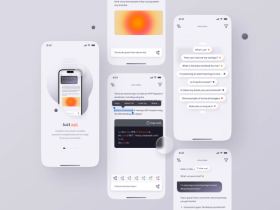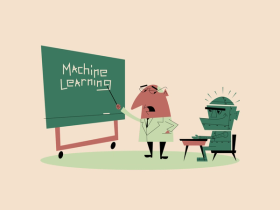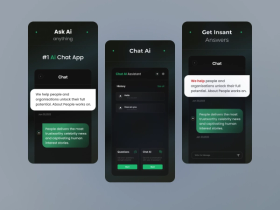In today’s digital world, which changes at the speed of light, the opportunity to effectively use language models is of growing importance for businesses and organizations. Recently, Large Language Models (LLMs) were introduced to the public, which can be considered essentially revolutionary, providing unique opportunities for solving a wide range of NLP tasks like text generation, translation, text summarization, and more. Learning how to make your own LLM and exploring ChatGPT integration can be incredibly beneficial in leveraging these opportunities.
This article helps the reader see a detailed guide on how to build your own LLM from the very beginning. In this subject, you will acquire knowledge regarding the main concepts of LLMs, the peculiarities of data gathering and preparation, and the specifics of model training and optimization. Furthermore, the advantages that the organization acquires when implementing and developing LLM on its own will be discussed, including grabbing the attention of a tech-savvy audience or a business executive willing to integrate AI into the company’s development plan.
This guide is all you need to create a LLM. After checking the following sections, you will find out about the possibilities to improve your operations and innovate thanks to a tailored LLM.
🤖 What is Large Language Models (LLM)?
LLMs are deep learning models built for an array of NLP tasks, and therefore represent a group of models in NLP. These tasks vary from **text production and translation to question answering and document summarization. **
The word 'large' here refers to the many parameters that these models have. When used in the context of this paper, parameters are understood to be the components of the model that are derived from the data during the learning phase.
Due to successful scaling, modern LLMs like GPT-4 and BERT can contain billions of parameters, allowing them to understand subsequent text and generate continuing contextualized text.

Large Language Models (LLMs) can be incredibly powerful for various NLP tasks, and with open source framework, you can make your own LLM tailored to specific needs.
(image by Ronas IT | UI/UX Team)
The market for this product is expected to grow rapidly in 2024 as massive language models continue to improve their ability to process input in human language. According to Springs, we can see how promising the field of LLM is:
- The worldwide LLM market will reach $259.8 million by 2030, up from $1,590 million in 2023. In the years 2023–2030, the CAGR will be 79.80%.
- With a CAGR of 72.17%, the market is expected to reach $105,545 million in North America by 2030.
- The top five LLM developers in the world in 2023 accounted for around 88.22% of market revenue.
- It's predicted that 750 million apps will use LLMs by 2025.
- Apps that use these language models are predicted to automate half of all digital jobs by 2025.
❓ Why Do You Need Your Own LLM?
Due to the ongoing advancements in technology, organizations are continuously looking for ways to improve their commercial proceedings, customer relations, and decision-making processes. Among the tools used, one can identify Large Language Models (LLMs) that play a significant role in these advancements, including innovative applications such as ML AI in the meditation industry.
But why should your organization embark on the establishment of its own LLM? Here are several convincing arguments for customized machine learning:
Customization and Precision
Some advantages of creating your own LLM include the following: The needs you have when developing your own LLM will be unique. Standard models, though potent, are intended for general implementation. Hence they might not solve your business problems with the same level of precision.

(video by Semiflat)
By developing LLM, this technique allows you to adapt the model for your data and fine-tune it on your dataset, thereby enabling it to be conversant with the terminologies and contextual nature of your industry. This level of customization results in a higher level of value for the inputs provided by the customer, content created, or data churned out through data analysis.
You can also explore the best practices integrating ChatGPT apps to further refine these customizations.
Reduced Dependency on External Providers
Working with third-party LLM suppliers has several drawbacks: high prices, possible service interruptions, and data protection issues. In this regard, building LLM models and assembling your own LLM mitigates this kind of reliance and provides more control over the technology and stack layers, with the inherent option to magnify or enhance them to better serve the organization. This freedom is especially important for organizations that value data security and do not wish to be locked into a particular service provider.
Enhanced Data Privacy and Security
Security of data is a major issue in business organizations that deal with data, particularly sensitive data. The use of external LLM services entails providing data to third-party vendors, which increases the susceptibility of data leaks and non-compliance with regulatory requirements. The ideas, strategies, and data of a business remain the property of the business when you make LLM model in a private mode, not exposed to the public.

Choosing to develop a private LLM can significantly enhance data privacy and security by ensuring sensitive information is kept in-house and under strict control.
(image by Keitoto)
You can be certain that information pertaining to your business would not reach the public domain or result in a violation of industry rules and regulations. This is especially crucial for sectors with data sensitivity, such as finance, healthcare, the legal profession, and others.
💡 Enhanced data privacy and security in Large Language Models (LLM) can be significantly improved by choosing Pinecone for vector storage, ensuring sensitive information remains protected.
Cost Efficiency
In constructing an LLM from scratch, a certain amount of resources and expertise are initially expended, but there are long-term cost benefits. Furthermore, developing information with the help of open-source tools and frameworks like TensorFlow or PyTorch can be significantly cheaper. Additionally, owning the model allows for adjustments in its efficiency and capacity in response to the business’s requirements without the concern of subscription costs for third-party services. When you create your own LLM, this cost efficiency could be a massive improvement for startups and SMEs, given their constrained budgets.
Competitive Advantage
Introducing a custom-built LLM into operations adds a solid competitive advantage in business success. Depending on the type of model your business requires, it is possible to enhance the effectiveness of interactions with clients using smarter chatbots and virtual personal assistants, generate high-quality content faster, and have richer data analysis. Such sophistication can positively impact the organization’s customers, operations, and overall business development.

Creating an LLM provides a significant competitive advantage by enabling customized solutions tailored to specific business needs and enhancing operational efficiency.
(image by Happy Tri Milliarta)
Regulatory Compliance
Numerous sectors of the economy face legal restrictions concerning the application of data and its protection. These regulations can be met using a private LLM because you are entirely in charge of the data used to train the model and the environment where it is deployed. This control assists in meeting the objectives of reducing risks stemming from non-compliance with regulations and in building the reputation of your organization as a trustworthy institution.
Innovation and Experimentation
Having your own LLM will allow for new ideas, architectures, and training methods to be tried out. You can also explore how to leverage the ChatGPT API in SaaS products to foster innovation. This freedom increases creativity and enables the business to explore possibilities that are ahead of the competition. This is a very powerful argument because having an in-house LLM means being able to respond to technological trends in a timely and effective manner and retaining one’s leadership in the market.
Adaptability to Evolving Needs
Although basic AI needs of your business can be met initially, as your business grows and develops, so does the complexity of the AI it needs. With a private LLM, there is always the possibility of improving and adapting it to the client’s needs in the long run. This flexibility ensures that your AI strengths continue to be synergistic with your future agendas, thus offering longevity.
All in all, having a private LLM offers many benefits, starting with a greater level of opportunities for customization and better protection of data, and ending with potential cost-saving and competitive advantages. When you decide to get your own LLM, you give your organization a powerful tool that fosters innovation, protects from legal risks, and is tailored to your organization’s needs. This strategic move can help in achieving a sustainable competitive advantage for your company in the fragile and volatile digital economy.
📚 Types of Large Language Model
When creating an LLM, one needs to understand the various categories of models that exist. Depending on the tasks and functions to be performed, LLMs can be classified into various types. Here, we have considered the principal types of LLMs to assist you in making the right choice.
Autoregressive Language Models
Autoregressive (AR) language models build the next word of a sequence based on preceding words. These models predict the probability of the next word using context, making them suitable for generating large, contextually accurate pieces of text. However, they lack a global view as they process sequentially, either forward or backward, but not both.
Autoregressive models are particularly useful for tasks such as:
- Responding to prompts and creating articles, stories, or other text-intensive content.
- Interpreting language where maintaining context is crucial.
- Autoencoding Language Models
Examples: GPT-3 and GPT-4: GPT-3 and GPT-4 are Generative Pre-trained Transformer models created by OpenAI. They generate human-like text and are used in content generation, language translation, and more.
Autoencoding Language Models
Autoencoding models, like Bidirectional Encoder Representations from Transformers (BERT), aim to reconstruct input from a noisy version. These models predict masked words in a text sequence, enabling them to understand both forward and backward dependencies of words.
Autoencoding models are suitable for:
- Brief text segments such as keywords, questions, or short descriptions (e.g., search queries or product descriptions).
- Tasks requiring extensive context, such as sentiment analysis.

Exploring the different types of Large Language Models, like autoregressive and hybrid models, is essential if you want to build your own LLM tailored to your needs.
(image by Golo)
Example: BERT is a transformer model developed by Google, pretrained on large text corpora, and fine-tuned for tasks like sentiment analysis, named entity recognition, and question answering.
Transformer-Based Models
The field of transformers uses the transformer architecture for input text to parse it into tokens and apply self-attention. Due to this, the model is capable of understanding the relations between tokens, unlike identifying relations between tokens in conventional models.
Example: BERT and GPT models: Both employ the transformer scheme. However, BERT is designed to treat contexts within texts, while GPT models are intended to generate texts corresponding to the given context.
Hybrid Models
There exists a relation between autoregressive models and autoencoding models, with the latter originating from the former as enhanced models. They are supposed to generate textual output from the input and should be able to learn enough to perform specific NLP tasks such as classification, generation, and translation.
Example: T5 (Text-to-Text Transfer Transformer): The next effective model developed by Google is T5, which is universal and effective due to the fact that it uses the idea of transfer learning based on a text-to-text model to complete multiple NLP tasks with high precision.

Hybrid models offer a versatile solution for creating an LLM model that excels in both text generation and contextual understanding.
(image by Conceptzilla)
Hybrid models offer:
- A useful property of generated text that does not contain massive self-copying and does not constantly produce random variations.
- The ability to be adapted in a better way to the particular application or use case, such as chatbots or virtual personal assistants.
Multilingual Models
Multilingual models are created on the basis of various language datasets, enabling them to process and synthesize text in different languages. They are very suitable for cross-lingual IR, multilingual bots, and MT.
Example: XLM (Cross-lingual Language Model): Less than a year old and created by Facebook’s sister company, XLM is intended to handle many languages and all aspects that require input from different cultures.
Deciding on the kind of large language model that suits you best depends on your styles and uses of the tool. Autoregressive models are better for creating high-quality text, like in news articles, while autoencoding models are good for understanding context if the input is shorter. Most current NLP tasks are dominated by a stable architecture built on transformers, and the use of hybrid models provides many opportunities to create versatile and constantly adjustable models.
When the complexity of language structures and algorithms is not very high, then a multilingual model is necessary for the given application. It is hoped that by now you have a clearer idea of the various types of LLMs available so that you can steer clear of some of the difficulties incurred when constructing a private LLM for your companies.
⚙️ Principle of Work and Main Components of LLM
In this section, we asked Stormotions experienced developer Andrian Yarotsky to talk about the principle of work and main components of LLM. Keep reading! 👇
LLMs are artificial neural networks that utilize the transformer architecture, invented in 2017 and described in the article "Attention Is All You Need". Transformer architecture leverages self-attention mechanisms to process input data in parallel, allowing it to capture contextual relationships over long distances more efficiently than traditional sequential models. This architecture, characterized by its encoder-decoder structure, excels in tasks such as natural language processing by modeling dependencies without regard to their position in the input sequence. All transformers share the same fundamental components:
Tokenizers: These convert text into tokens.
Embedding Layer: This single layer transforms tokens and their positions into vector representations.
Transformer Layers: These layers perform repeated transformations on the vector representations, extracting increasingly complex linguistic information. They consist of alternating attention and feedforward layers.
(Optional) Un-embedding Layer: This layer converts the final vector representations back into a probability distribution over the tokens.
Transformer layers come in two types: encoders and decoders. The original Transformer model used both types, but later models typically use only one. For instance, BERT is an encoder-only model, while GPT models are decoder-only.
🛠️ How to Build Your Own LLM Step-by-Step
Building an LLM model from initial data collection to final deployment is a complex and labor-intensive process that involves many steps. Our developer Andrian Yarotsky will provide more details about this.
Define Objectives and Requirements.
Defining objectives and requirements is the first critical step in creating an LLM. It involves determining the specific goals of the model, such as whether it will be used for text generation, translation, summarization, or another task. This stage also includes specifying performance metrics, model size, and deployment requirements to ensure the final product meets the intended use cases and constraints.
Data Collection
Data collection is essential for training an LLM, involving the gathering of large, high-quality datasets from diverse sources like books, websites, and academic papers. This step includes data scraping, cleaning to remove noise and irrelevant content, and ensuring the data's diversity and relevance. Proper dataset preparation is crucial, including splitting data into training, validation, and test sets, and preprocessing text through tokenization and normalization.

Proper dataset preparation ensures the model is trained on clean, diverse, and relevant data for optimal performance.
(image by Dmitry Starikov)
Model Architecture Design
Model architecture design involves selecting an appropriate neural network structure, such as a Transformer-based model like GPT or BERT, tailored to language processing tasks. It requires defining the model's hyperparameters, including the number of layers, hidden units, learning rate, and batch size, which are critical for optimal performance. This phase also involves planning the model's scalability and efficiency to handle the expected computational load and complexity.
Training the Model
Training the model is a resource-intensive process that requires setting up a robust computational infrastructure, an essential aspect of how to build LLM, often involving GPUs or TPUs. The training loop includes forward propagation, loss calculation, backpropagation, and optimization, all monitored through metrics like loss, accuracy, and perplexity. Continuous monitoring and adjustment during this phase are crucial to ensure the model learns effectively from the data without overfitting.
You can also read about how to make a chatbot using JS to integrate with your LLM for better performance.
Fine-tuning and Optimization
Fine-tuning and optimization are performed to adapt a pre-trained model to specific tasks or domains and to enhance its performance. Transfer learning techniques are used to refine the model using domain-specific data, while optimization methods like knowledge distillation, quantization, and pruning are applied to improve efficiency. This step is essential for balancing the model's accuracy and resource usage, making it suitable for practical deployment.
🏋️ How to Train Custom Large Language Model
Building custom LLM from scratch involves several practical steps and technologies, which our developer Andrian will also discuss:
Firstly, you'll need a substantial dataset, which can be gathered from diverse sources like web scraping, open datasets, or proprietary data, and then preprocessed to remove noise and irrelevant information.
Libraries such as BeautifulSoup for web scraping and pandas for data manipulation are highly useful. Once the data is ready, the model architecture needs to be defined, with Transformer-based models like GPT-3 or BERT being popular choices.

Training a custom large language model requires gathering extensive, high-quality datasets and leveraging advanced machine learning techniques.
(image by Rusdhy Jasmin)
Frameworks such as TensorFlow and PyTorch provide robust tools for building and training these models, with Hugging Face's Transformers library offering pre-built architectures and utilities to simplify the process. Training a large language model demands significant computational power, often requiring GPUs or TPUs, which can be provisioned through cloud services like AWS, Google Cloud, or Azure.
Monitoring tools such as TensorBoard can help track training progress and performance metrics like loss and accuracy, enabling adjustments to hyperparameters for optimal results.
Retrieval-Augmented Generation (RAG) is an alternative approach that combines the strengths of retrieval-based methods with generative AI models. Instead of training a model from scratch, RAG leverages a retriever to fetch relevant documents from a pre-existing corpus and a generator to produce coherent and contextually accurate responses. This approach is particularly advantageous when dealing with specific, domain-focused tasks where the corpus contains highly specialized information.

Using RAG can significantly reduce the computational and data requirements compared to training a new model from scratch. Moreover, RAG is effective for scenarios where up-to-date information is critical, as the retriever can dynamically pull in the latest data, ensuring the generated output is both accurate and relevant. Integrating RAG can be efficiently done using frameworks like Hugging Face's Transformers, which supports RAG models and offers pre-trained components that can be fine-tuned for specific applications.
Andrian Yarotskyi, Developer @ Stormotion
🏔️ Challenges in Creating an LLM
Assembling one individually from the ground up is a herculean task, especially for small to medium businesses, large entities, or startups that may already have some experience with LLMs but now want to gain a fuller appreciation of what is involved. Below are the primary challenges that you may face during this complex process:
Data Collection and Quality
Effective training of a satisfactorily performing LLM entails the use of a massive amount of data that possesses high variety. Collection of such data can sometimes be a very difficult endeavor. The data needs to be diverse in the topics discussed, languages used, and environments in which the information was made available online.

(video by Cadabra Studio)
Controlling the content of the data collected is essential so that data errors, biases, and irrelevant content are kept to a minimum. Low-quality data impacts the quality of further analysis and the models built, which affects the performance of the LLM.
Computational Resources
Training LLMs, especially those with billions of parameters, requires large amounts of computation. This includes GPUs or TPUs, which are pricey and heavily energy-intensive.
It can sometimes be technically complex and laborious to coordinate and expand computational resources to accommodate numerous training procedures.
Model Complexity
It is crucial to correctly select the architecture of LLM (for example, autoregressive, autoencoding, or combined ones) depending on the concrete problem that is going to be solved. Each architecture has its advantages and disadvantages, and a wrong decision can lead to poor results.
Tweaking the hyperparameters (for instance, learning rate, size of the batch, number of layers, etc.) is a very time-consuming process and has a decided influence on the result. It requires experts, and this usually entails a considerable amount of trial and error.
Data Privacy and Security
There are privacy issues during the training phase when processing sensitive data. The importance of enforcing measures such as federated learning and differential privacy cannot be overemphasized. However, they increase the difficulty level.
It is obligatory to be compliant with data protection regulations (for example, GDPR, CCPA). This requires proper management of data and documentation so that an organization will not fall prey to legal actions.

Data privacy and security in creating an LLM are critical, as they involve ensuring compliance with regulations like GDPR and preventing sensitive data leaks during the training phase.
(image by Irakli Lolashvili)
Cost Management
The monetary investment to create a LLM model for data acquisition, computing resources, and talent is a huge capital investment that one has to make. These costs may, however, be expensive for SMEs that may not be in a position to meet the costs as big organizations do.
There are additional costs that accompany the maintenance and improvement of the LLM as well. Since developing the LLM was not a one-time process, sustaining and enhancing it also has recurring expenses. Efficiency of resource management is needed to prevent these costs from escalating.
Expertise and Talent
Therefore, developing, and especially tuning, an NLP model such as an LLM entails knowledge in machine learning, data science, and more specifically in NLP. Securing such talent is quite a process, especially when the market is competitive, and human resources must endure a learning curve before the candidate is actually hired.
The field in which LLMs are concentrated is dynamic and developing very fast at the moment. To remain informed of current research as well as the available technological solutions, one has to learn constantly. It is about constant development.
Ethical Considerations
It is important to eliminate bias in the model and reflect on the model’s potential for presenting a fair outcome. This includes paying particular attention to the data that is used during training and measures put in place to counteract this.
Staying ahead of the curve when it comes to how LLMs are employed and created is a continuous challenge due to the significant danger of having LLMs that spread information unethically.
Perhaps, it is a great challenge to create your own LLM due to many technical, financial, and ethical barriers. That being said, if these components are thought through and executed to the best of one's abilities, there is a way to design the model to your needs and offer rather tangible competitive advantages.
🧑💼 Create Your Own Private LLM With the Help of Stormotion Experts
Despite the fact that creating LLMs is a relatively new trend in the market, we already have experience in this area. In this section, our developer Andrian Yarotsky will explain how to create an LLM from scratch, and at the end, we will share our own experiences in this field. Keep reading!
To build LLM model from scratch we'll utilize PyTorch library. This example demonstrates the basic concepts without going into too much detail. We'll use a basic RNN model for illustration purposes. In practice, you would likely use more advanced models like LSTMs or Transformers and work with larger datasets and more sophisticated preprocessing.
Next we'll implement a simple RAG using LangChain.js. We'll basically just ad a retrieval-augmented generation to a LLM chain. We'll use OpenAI chat model and OpenAI embeddings for simplicity, but it's possible to use other models including those that can run locally.

Developing a custom large language model (LLM) from scratch is not always the most rational approach due to its high cost, complexity, and resource demands. Instead, using ready-made solutions like OpenAI's ChatGPT offers a streamlined path to harnessing advanced AI capabilities without the extensive overhead of developing a model from the ground up.
Andrian Yarotskyi, Developer @ Stormotion
When to Develop Your Own LLM: | When to Use Ready-Made Solutions: |
|
|
Connecting this idea with our company’s experience, we effectively utilized the concept of ready-made solutions in the Art of Comms project. Within this project, we are implementing advanced artificial intelligence technologies to automate the process of content review. We seamlessly integrate various intelligent tools, tailoring the solution to our specific needs without the complexities of building an LLM from scratch.
By using needed platform, we avoid the necessity of deep machine learning expertise and instead focus on combining powerful, pre-trained models and AI platforms to automate the processing of large volumes of data. This strategy not only ensures high-quality results but also makes the process efficient and fast, maintaining high standards in communication arts and upholding our commitment to innovative and effective solutions.
👂Takeaways
Training an LLM from scratch is an ambitious but highly rewarding task. This guide describes the core steps of the process – the definition of aims and objectives, data collection, training, model tuning, and optimization. The benefits of developing a specific LLM include more precision and specialization, better data protection and security, reduced dependence on third-party services, and even cost efficiency.
On the other hand, the choice of whether to develop a solution in-house and custom develop your own LLM or to invest in existing solutions depends on various factors. For example, an organization operating in the healthcare sector dealing with patients’ personal information could build custom LLM to protect data and meet all requirements. On the other hand, a small business planning to improve interaction with customers with the help of a chatbot is likely to benefit from using ready-made options such as OpenAI GPT-4.
If you have any questions or are looking for a company to help you build an LLM from scratch or integrate ready-made solutions, please reach out to us. We're here to assist you in achieving your AI goals!


![Stormotion client Pietro Saccomani, Founder from [object Object]](/static/40e913b6c17071a400d1a1c693a17319/b0e74/pietro.png)




